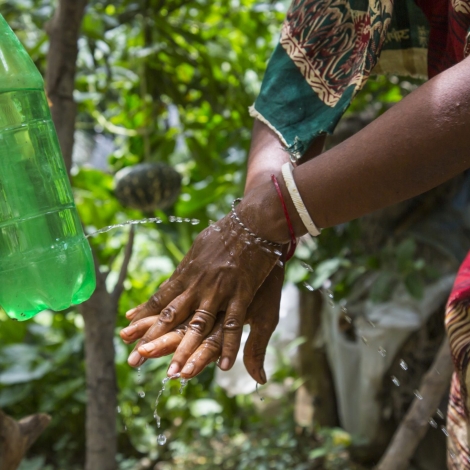Handwashing with ash or soil is traditional in impoverished or remote communities that do not have easy access to soap. Are those methods effective at preventing the spread of the novel coronavirus? The question arose in an email discussion among members of the Rural Water Supply Network. Experts weighed in from around the world, and the short answer appears to be “probably.”
The accurate answer, of course, is that there is not enough evidence to make a claim. But research on handwashing with soil and ash exists, and it may be possible to infer the efficacy of those materials against coronavirus from studies that never examined the virus specifically. There is precedent for that kind of guesswork. Before studies were available on the efficacy of masks, for example, health experts were recommending them based on research into other diseases. Eventually, studies on COVID-19 proved the validity of the recommendations.
Official WASH guidelines
The joint WHO-UNICEF WASH technical brief on water, sanitation, hygiene and waste management for COVID-19 issues a recommendation for handwashing.
Frequent and correct hand hygiene is one of the most important measures to prevent infection with the COVID-19 virus. WASH practitioners should work to enable more frequent and regular hand hygiene by improving access to hand hygiene facilities and using multimodal approaches…
And, in the absence of soap, a WHO brief offering interim guidance on WASH for COVID-19 management recommends ash, soil or water alone.
When soap or alcohol-based hand rub are not available, the use of ash or soil can be considered and has shown to be effective in some cases. Ash, in particular, may inactivate pathogens by raising the pH. However, in communities with limited sanitation services, soil may be faecally contaminated, and thus it is important to weigh the benefits against the risk of contaminating hands. Finally, washing with water alone, although the least effective of the four options, this can result in reductions in faecal contamination on hands and in diarrhoea. Regardless of the type of material, the washing and rubbing of hands, and the amount of rinsing water in particular, are important determinants in the reduction of pathogen contamination on hands.
Rinsing and the action of rubbing the hands together while washing appear to be as important or more so than the material used to clean the hands. So long as the handwashing material is not contaminated, of course.
What the research suggests
Writing in the RWSN discussion, Emma Kelly, Communications and Knowledge Management Specialist at the University of North Carolina Water Institute, cites four studies that inform the recommendation for ash or (disinfected) soil.
Anuradha and colleagues published a study based in India in 1999 in the Indian Journal of Pediatrics in which they swabbed children’s hands for bacteria before and after washing with soap or ash. They found that washing with both materials reduced bacterial contamination significantly.
A. Hoque and a colleague published a study based in Bangladesh in 1991 in the Journal of Tropical Medicine and Hygiene in which they tested for bacterial contamination on the hands of 20 women after washing with mud, ash or soap. The researchers found that mud and ash were as efficient as soap.
Another more recent study in Bangladesh, published in 2014 in the American Journal of Tropical Medicine and Hygiene, found that washing with ash and water reduced fecal indicator bacteria on hands, and that diarrhea was equally likely for children of caretakers who used ash versus soap.
A review of research on handwashing with ash and mud published in 2009 by the International Scientific Forum on Home Hygiene determines that the materials can remove pathogens from hands. The risk, however, is that soil or ash may be contaminated with parasites or other infectious organisms, heavy metals such as arsenic, or pesticides.
More resources
Many other resources shed light on the topic. A recently updated article on Hygiene Hub offers more than a dozen references. Experts in the Sustainable Sanitation Alliance (SuSanA) offered their views on handwashing with ash in an online forum in 2015. And the Centre for Affordable Water and Sanitation Technology (CAWST) issued the video below on handwashing, with a mention of the use of ash.
And one final resource: This WHO document describes how to make your own sanitizer from ethanol or isopropyl alcohol and other ingredients: Guide to Local Production.


This is a very well written information. WHO and UNICEF should also research more with scientist on this issue.